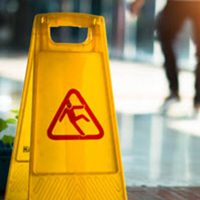Breaking Down a Slip-and-Fall Claim

Every year, slip-and-fall injuries send over eight million Americans to hospital emergency rooms. Common wounds include a head injury and a broken pelvis. In many cases, these injuries are life threatening. In all cases, these wounds have severe physical and emotional effects. Broken bones can cause permanent loss of mobility. Emotionally, to avoid another fall, many of these victims basically become prisoners in their own homes.
Because of these severe tangible and intangible injuries, a Seattle slip and fall lawyer can often obtain substantial compensation in these cases. However, these cases have lots of moving parts, as outlined below. Furthermore, an out-of-state company may own the grocery store, nursing home, restaurant, or other commercial facility where the fall occurred. That fact adds another dimension to an already complicated claim. To approach such a claim, a Seattle personal injury attorney usually breaks the matter down into two basic components.
Duty of Care
Negligence is basically a lack of care. Therefore, most negligence cases begin with the duty of care. The more responsibilities the law imposes on an owner, the more likely it is that the owner has violated those responsibilities.
Washington law sets three duties of care in premises liability cases, in accordance with the owner’s relationship to the victim.
- Invitee: If the victim was an invited commercial or noncommercial guest, and the victim’s presence benefited the owner in any way, the owner had a duty of reasonable care to ensure that the property is reasonably safe. These owners must promptly address injury hazards, like loose stairway handrails.
- Licensee: Most people have permission to visit hospital patients, but the hospital owner usually gains nothing, financially or non-financially. Since the relationship isn’t as close, the owner only has a duty to warn about hidden (latent) defects. Sometimes, a licensee becomes an invitee. A hospital patient’s guest might buy something at the gift shop.
- Trespassers: Licensees or invitees might become trespassers. Hospital guests who stay past visiting hours are trespassers. At that point, they don’t have permission to be at the facility. Injured trespassers usually have no legal recourse against property owners. Stories of injured burglars who successfully sue homeowners are mostly urban myths.
Knowledge of Hazard
The law punishes people based on their actions or inactions, not based on their status. In this situation, the action or inaction is knowledge, or lack thereof, of the injury hazard. Evidence on this point could be direct or circumstantial.
Direct evidence of actual knowledge, like a prior complaint about the same injury hazard, is usually the most convincing proof on this point. Seattle personal injury lawyers typically don’t find such evidence until discovery, which is an evidence-exchange process during litigation. So, if a fall injury claim settles too early, the best evidence, and therefore maximum compensation, may be unavailable.
Courts use the time-notice rule to evaluate circumstantial evidence of constructive knowledge (should have known). The longer a hazardous condition exists, the greater the likelihood that the property owner should have known about it.
Count on a Diligent King County Lawyer
Sip-and-falls cause serious injuries. For a free consultation with an experienced personal injury lawyer in Seattle, contact the Emerald Law Group.
Source:
nfsi.org/nfsi-research/quick-facts/
